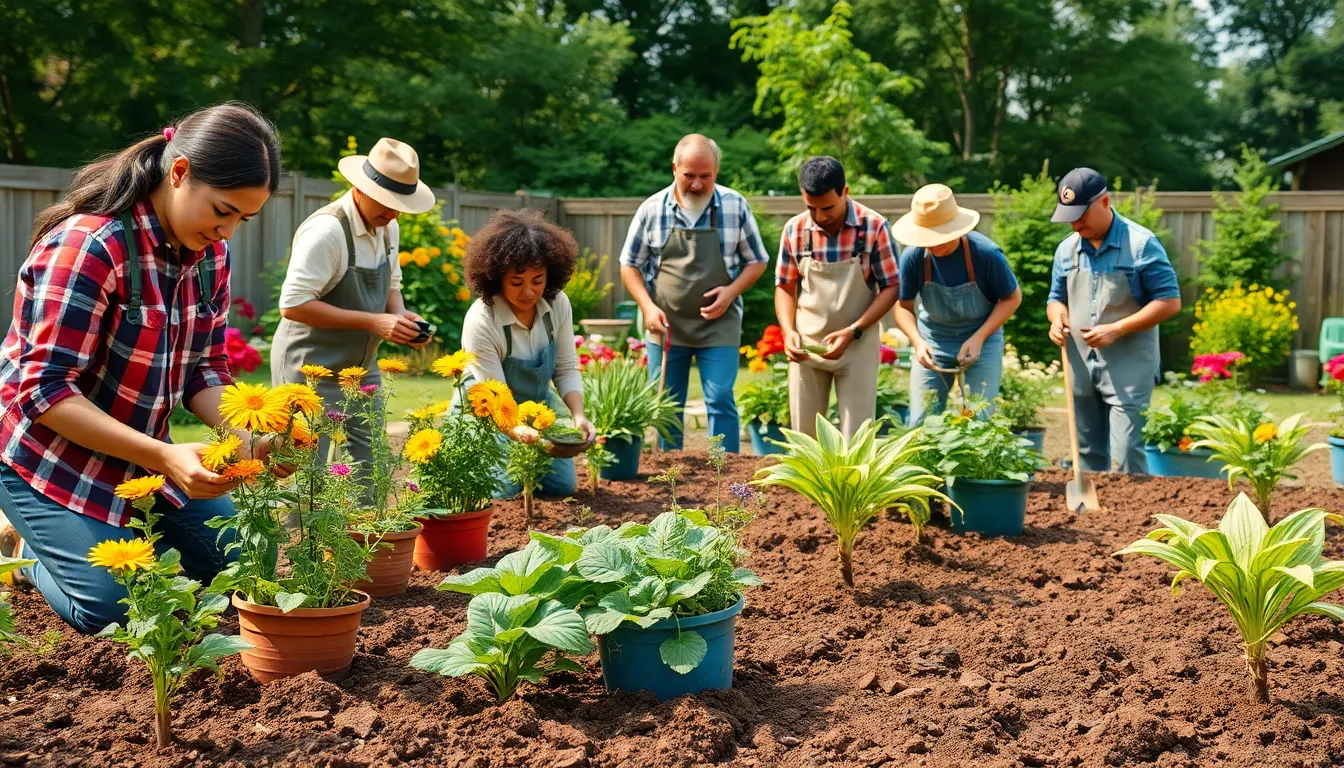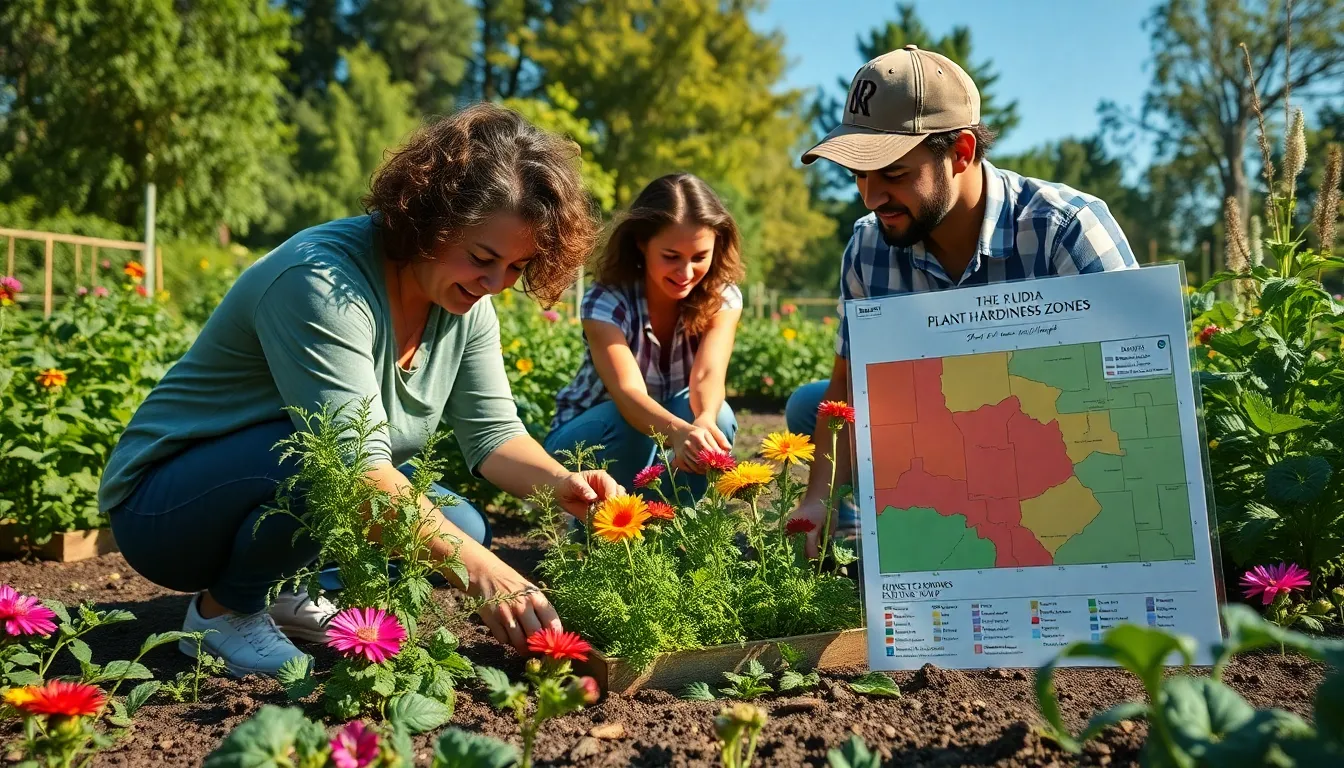When it comes to gardening, knowing your zone is like knowing your star sign—it’s crucial for a thriving garden, but way less mystical. Each gardening zone tells you what plants will thrive in your climate, so you won’t end up trying to grow tropical fruits in the Arctic. Trust us, your tomato plants will thank you!
Table of Contents
ToggleUnderstanding Gardening Zones
Gardening zones determine which plants thrive in specific climates. Each zone indicates the average minimum temperature experienced throughout the year. The USDA Plant Hardiness Zone Map divides regions into 13 zones based on these temperature ranges, making it easier for gardeners to select appropriate plants.
Gardeners often use these zones to choose plants suited for their local environment. Cold-hardy species, for instance, flourish in Zones 3 and 4, while tropical varieties may only survive in Zones 9 and above. Local conditions, like soil type and moisture levels, can also influence plant success, making zone knowledge essential.
Identifying one’s gardening zone starts with assessing the local climate. Websites and resources provided by the USDA can help pinpoint the exact zone. This knowledge also helps avoid costly mistakes, such as planting species that won’t survive winter.
Microclimates often exist within larger zones. Small variations in temperature and exposure to sunlight create unique growing conditions. Inspecting these factors can lead to better planting decisions.
Gardeners should consult local extension services or agricultural experts for tailored advice. They can offer insights into regional plants that grow well in specific zones. Familiarity with companion planting techniques enhances the gardening experience by promoting healthy plant relationships.
Using gardening zones wisely enables successful planting and increased enjoyment of gardening. Recognizing the significance of these zones leads to fruitful results that align with one’s gardening aspirations.
Importance Of Knowing Your Gardening Zone

Knowing your gardening zone provides crucial insight into successful gardening practices. Each zone correlates with specific climate conditions and plant species adaptability.
Climate Considerations
Climate plays a vital role in gardening success. Understanding your local climate helps select plants that thrive under prevailing conditions. Specific temperature ranges define each gardening zone, influencing everything from frost dates to heat levels. For example, Zones 3 and 4 experience harsher winters, making cold-hardy plants advantageous. They handle lower temperatures better compared to those in warmer zones. Additionally, local weather patterns, soil types, and moisture levels further shape plant growth. Knowledge of these factors aids in making informed gardening decisions.
Plant Selection
Selecting the right plants enhances gardening success significantly. Knowledge of gardening zones informs choices about plant hardiness and suitability. For instance, tropical fruits flourish in Zones 9 and higher, while other species prefer cooler zones. Proper plant choices minimize the risk of failure, particularly during harsh weather. Gardeners should also consider local microclimates that may support different plant varieties. Resources like the USDA Plant Hardiness Zone Map provide essential guidance. Accessing this information leads to selecting plants that will thrive, ensuring a vibrant and flourishing garden.
How To Determine Your Gardening Zone
Determining your gardening zone involves using specific tools and resources. Understanding these tools enhances plant selection and gardening success.
USDA Plant Hardiness Zone Map
The USDA Plant Hardiness Zone Map provides essential guidance for gardeners. This map categorizes regions into 13 zones based on average minimum temperatures. For instance, Zones 3 and 4 feature cold-hardy plants, while Zones 9 and higher support tropical varieties. Accessing this map allows gardeners to make informed choices about which species will thrive in their climate. Specific temperature ranges define each zone, making it straightforward to choose plants suited for local conditions.
Tools And Resources Available
Several tools and resources assist in determining gardening zones. Online calculators, like those from the USDA, offer personalized results based on ZIP codes. Mobile apps provide convenient access to gardening information specific to regions. Additionally, local extension services furnish expert advice tailored to unique microclimates. Gardeners can also explore community forums for shared experiences. Utilizing these resources ensures informed decisions and fosters successful gardening practices.
Tips For Gardening In Your Zone
Understanding specific recommendations can help maximize gardening success. Each zone features unique conditions, influencing plant choices and care practices.
Planting Recommendations
Choose plants suited for your gardening zone’s climate. For example, select cold-hardy varieties for Zones 3 and 4, while tropical fruits thrive better in Zones 9 and above. Native plants often adapt more easily, requiring less maintenance and resources. Incorporate companion planting to enhance growth and pest resistance; examples include pairing tomatoes with basil. Utilize the USDA Plant Hardiness Zone Map to guide selection and ensure compatibility with local temperatures.
Seasonal Care Tips
Different seasons demand tailored care based on gardening zones. During spring, focus on frost dates to determine appropriate planting times. In summer, monitor moisture levels, as hotter climates may cause plants to require more frequent watering. Fall maintenance includes mulching to protect root systems from colder temperatures. For winter, plan ahead by researching species that sustain minimal growth during harsh cold. Adjusting care routines each season significantly improves plant health and longevity.
Understanding one’s gardening zone is crucial for thriving plants and a successful garden. By identifying the appropriate zone and considering local conditions, gardeners can make informed decisions that enhance their gardening experience. Utilizing resources like the USDA Plant Hardiness Zone Map and local extension services provides valuable insights tailored to specific climates.
With the right plant selections and seasonal care, gardeners can cultivate a vibrant landscape that flourishes throughout the year. Embracing the unique characteristics of each gardening zone not only prevents costly mistakes but also fosters a deeper connection with nature. Ultimately, knowledge of gardening zones empowers individuals to create beautiful and sustainable gardens that reflect their personal aspirations.



